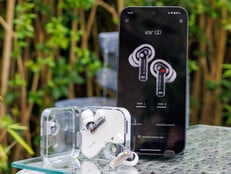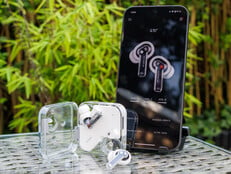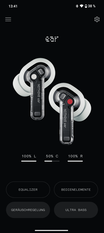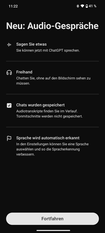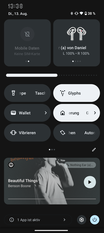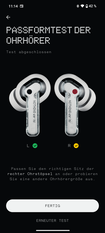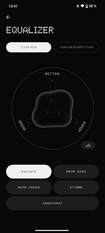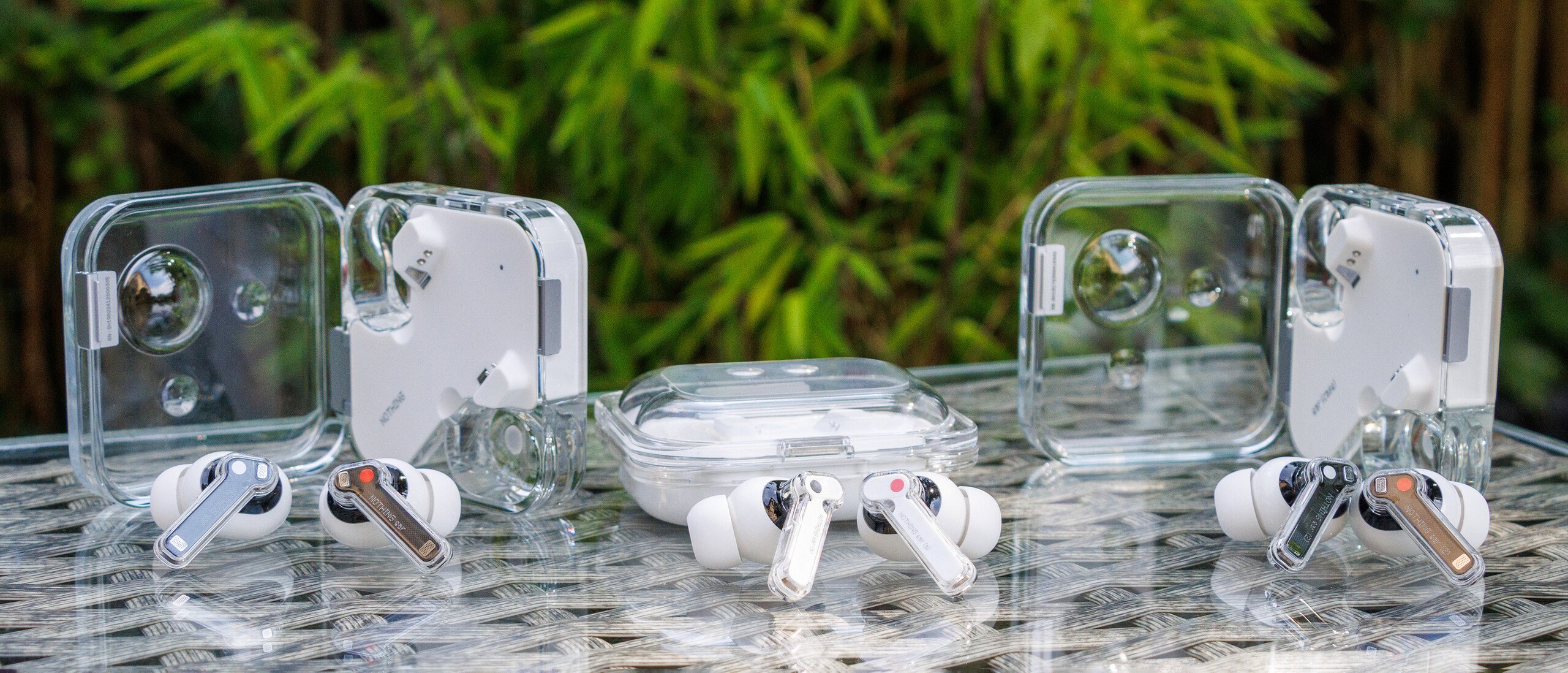
对比测试:所有最新无线 Nothing 耳机评测
只有声音
Nothing 不仅生产智能手机,还生产入耳式耳机。我们测试了所有三个型号:去年的 Nothing Ear (2)、顶级的 Nothing Ear 和价格更实惠的 Nothing Ear (a)。请阅读这篇评测,看看哪款最好。Daniel Schmidt, 👁 Daniel Schmidt (translated by DeepL / Ninh Duy) Published 🇺🇸 🇩🇪 ...
这些 TWS 耳机的名称有点混乱,因为 Nothing Ear (2) 是 Nothing Ear 的前身。另一方面,Nothing Ear (a) 则是更经济实惠的型号;它们的命名基于制造商的智能手机,其中的 Phone (2a)代表更便宜的入门级产品。
Nothing Ear 和 Ear (2) 的最高售价为 159.99 美元,而 Ear (a) 则要便宜 50 美元。除了高分辨率音频外,所有型号还承诺集成 ChatGPT。
规格
| Nothing Ear | Nothing Ear (2) | Nothing Ear (a) | |
|---|---|---|---|
| 类型 | 入耳式 | 入耳式 | 入耳式 |
| 连接性 | 蓝牙 5.3 | 蓝牙 5.3 | 蓝牙 5.3 |
| 覆盖范围 | 10 米 | 10 米 | 10 米 |
| 驱动器 | 11.6 毫米陶瓷 | 11.6 毫米石墨烯 + PU | 11 毫米 PMI + TPU |
| 音频编解码器 | SBC、AAC、LDAC、LHDC 5.0 | SBC、AAC、LDAC、LHDC 5.0 | SBC、AAC、LDAC |
| ANC | 智能 ANC,最高 45 分贝 | 最高 40 分贝 | 智能 ANC,最高 45 分贝 |
| 电池容量 | 46 mAh (耳机)500 mAh (外壳) | 33 mAh (耳机)485 mAh (外壳) | 46 mAh (耳机)500 mAh (外壳) |
| 充电连接 | USB-C | USB-C | USB-C |
| 无线充电 | 是 | 是 | 否 |
| 认证 | IP54(耳机)IP55(外壳) | IP54(耳机)IP55(外壳) | IP54(耳机)IPX2(外壳) |
| 重量 | 4.62 克(耳机)51.9 克(外壳) | 4.5 克(耳机)51.9 克(外壳) | 4.8 克(耳机)39.6 克(外壳) |
| 固件版本 | 1.0.1.52 | 1.0.1.102 | 1.0.1.45 |
| 价格 (MRSP) | 149 欧元 | 149 欧元 | 99欧元 |
» Notebookcheck多媒体笔记本电脑Top 10排名
» Notebookcheck游戏笔记本电脑Top 10排名
» Notebookcheck低价办公/商务笔记本电脑Top 10排名
» Notebookcheck高端办公/商务笔记本电脑Top 10排名
» Notebookcheck工作站笔记本电脑Top 10排名
» Notebookcheck亚笔记本电脑Top 10排名
» Notebookcheck超级本产品Top 10排名
» Notebookcheck变形本产品Top 10排名
» Notebookcheck平板电脑Top 10排名
» Notebookcheck智能手机Top 10排名
» Notebookcheck评测过最出色的笔记本电脑屏幕
» Notebookcheck售价500欧元以下笔记本电脑Top 10排名
» Notebookcheck售价300欧元以下笔记本电脑Top 10排名
外壳和人体工学设计 - 带有不同驱动器的 Nothing Ears
Nothing Ears 有黑色和白色两种颜色,只有 Ear (a) 还有黄色。所有耳机都通过了 IP54 防护等级认证,即可以防止有害灰尘进入,也可以防止水从四面八方溅入。在耳机外壳方面,Ear (a) 不得不做出一些小小的妥协,因为它们只能防止滴水,而更昂贵的型号则通过了 IP55 认证。
耳机配有三种尺寸的硅胶耳塞。入耳式耳机能很好地贴合您的耳道;为了确保最佳的贴合度,您可以通过应用程序进行贴合度测试,测试结果会给出结论。虽然耳机能牢固地佩戴在耳道中,但并不像 Jabra Elite 8 Active 那样紧密,这就是为什么它只在有限的范围内适合流汗活动--这取决于运动的类型。
如果将耳机直接放在一起,它们之间几乎没有任何视觉差异。但耳机盒就不同了--尽管仍有可能与更昂贵的型号混淆。不过,看一下驱动单元的保护网就会发现一些不同之处,而且制造商为它们的驱动单元所使用的材料也不尽相同。在这方面,Nothing Ear(2024)采用了最高质量的材料,即陶瓷。
连接和操作 - 结构清晰的应用程序 无 X
得益于 Microsoft Swift Pair 和 Google Fast Pair,配对 Nothing TWS 变得超级快速和简单,因为Android 和 Windows 都能直接将它们识别为配对伙伴。Apple 用户必须使用传统的配对过程。配对过程可在每个型号的外壳上手动启动。所有入耳式耳机都具有双蓝牙功能,因此可以同时连接两台设备。
Nothing X应用程序用于管理和控制 TWS 耳机。您可以从 Google Play Store 和Apple App Store 下载该应用程序,也可以直接从 Nothing 下载 APK。除其他功能外,该应用程序还可用于安装固件更新、设置要使用的音频编解码器,以及设置预定义或自定义均衡器。您还可以在这里配置噪音抑制、透明度模式和入耳式耳机的控制。
这两款耳机之间的一个区别是,Ear(2023)仍然使用实体按键,而两款较新的耳机则依靠触摸感应器。耳机两侧的控制按钮都可以自定义。此外,还可以只使用一个耳塞,例如将 TWS 作为单声道耳机使用。
耳机还具有佩戴者识别功能,但只能开启或关闭。您还可以按下听筒激活智能手机的语音助手,或者使用 ChatGPT。不过,在我们的测试中,后者只有在智能手机解锁的情况下才能使用。
声音 - 并非所有 Nothing-TWS 都有 LHDC 5.0
就声音而言,日常使用中的差异比它们各自的数据表所显示的要小。Nothing Ear 采用的是陶瓷驱动器,而其他两个型号则使用了大量热塑材料。此外,Nothing 取消了 Ear(a)对 LHDC 编解码器的支持,这意味着不再提供个性化声音功能--该功能可根据佩戴者的听力调整声音输出。从技术上讲,LHDC 5.0 编解码器是有史以来功能最强大的编解码器之一,而且还具有低延迟的特点。但需要注意的是,并非所有智能手机都支持它。另一方面,LDAC 至少被所有相当现代的Android 智能手机所支持;只有Apple 用户只能使用 AAC。
所有这些耳机的音质都非常好。尤其是在激活超重低音功能时(新款耳机都有这种功能),低音的再现效果非常好。这只是品味问题。坦率地说,老款 Ear (2) 在这方面听起来更平衡,也更柔和。在超高音调方面,Nothing 耳机很快就会出现问题。不过,总的来说,声音还是不错的。
| Loudspeakers | |
| THD | |
| Nothing Ear (a) (RMS: -1.8 dBFS) | |
| Nothing Ear (2) (RMS: -2.7 dBFS) | |
| Nothing Ear (RMS: -1.2 dBFS) | |
| THD+N | |
| Nothing Ear (RMS: -1.2 dBFS) | |
| Nothing Ear (a) (RMS: -1.8 dBFS) | |
| Nothing Ear (2) (RMS: -2.7 dBFS) | |
* ... smaller is better
THD(总谐波失真):谐波失真量化了非线性失真(谐波含量)引起的分量相对于原始信号的大小。THD 仅指基波分量。失真系数经常被同时提及,但指的是整体信号。
THD+N(总谐波失真 + 噪音):该值与 THD 相似,但除了谐波的干扰功率外,噪声的干扰功率也作为有效值记录下来。
测量时,通过我们测试的耳机播放低谐波正弦波信号(1 kHz,> 0 dB),该信号由人工头中的线性测量麦克风(测量距离:约 1 厘米)记录。
两个数值均以百分比表示。数值越小,信号保真度越高。
Nothing Ear audio analysis
(+) | speakers can play relatively loud (88.9 dB)
Bass 100 - 315 Hz
(-) | nearly no bass - on average 25.1% lower than median
(+) | bass is linear (5.1% delta to prev. frequency)
Mids 400 - 2000 Hz
(±) | reduced mids - on average 8.8% lower than median
(±) | linearity of mids is average (10% delta to prev. frequency)
Highs 2 - 16 kHz
(-) | very high highs - on average 19.9% higher than median
(±) | linearity of highs is average (10.4% delta to prev. frequency)
Overall 100 - 16.000 Hz
(-) | overall sound is not linear (36.9% difference to median)
Compared to same class
» 94% of all tested devices in this class were better, 1% similar, 6% worse
» The best had a delta of 4%, average was 24%, worst was 134%
Compared to all devices tested
» 94% of all tested devices were better, 1% similar, 6% worse
» The best had a delta of 4%, average was 24%, worst was 134%
Nothing Ear (2) audio analysis
(+) | speakers can play relatively loud (92.7 dB)
Bass 100 - 315 Hz
(±) | reduced bass - on average 13.7% lower than median
(+) | bass is linear (3.6% delta to prev. frequency)
Mids 400 - 2000 Hz
(±) | higher mids - on average 9% higher than median
(±) | linearity of mids is average (7.6% delta to prev. frequency)
Highs 2 - 16 kHz
(±) | higher highs - on average 12.5% higher than median
(±) | linearity of highs is average (7.3% delta to prev. frequency)
Overall 100 - 16.000 Hz
(±) | linearity of overall sound is average (22.3% difference to median)
Compared to same class
» 62% of all tested devices in this class were better, 6% similar, 31% worse
» The best had a delta of 4%, average was 24%, worst was 134%
Compared to all devices tested
» 62% of all tested devices were better, 6% similar, 31% worse
» The best had a delta of 4%, average was 24%, worst was 134%
Nothing Ear (a) audio analysis
(+) | speakers can play relatively loud (90.8 dB)
Bass 100 - 315 Hz
(-) | nearly no bass - on average 20.1% lower than median
(+) | bass is linear (4.3% delta to prev. frequency)
Mids 400 - 2000 Hz
(±) | reduced mids - on average 7.7% lower than median
(±) | linearity of mids is average (8.6% delta to prev. frequency)
Highs 2 - 16 kHz
(-) | very high highs - on average 18.7% higher than median
(±) | linearity of highs is average (11.2% delta to prev. frequency)
Overall 100 - 16.000 Hz
(-) | overall sound is not linear (31.2% difference to median)
Compared to same class
» 89% of all tested devices in this class were better, 2% similar, 9% worse
» The best had a delta of 4%, average was 24%, worst was 134%
Compared to all devices tested
» 89% of all tested devices were better, 2% similar, 9% worse
» The best had a delta of 4%, average was 24%, worst was 134%
电池寿命 - Nothing Ear 2024 的电池容量更大
我们在激活 ANC(最高级别)并使用 LDAC 编解码器的情况下对所有型号进行了运行时间测试。在调整音量为 65 分贝(A)的条件下,两款 2024 型号耳机的续航时间略低于 6 小时,而去年的 Ear (2) 型号耳机则提前了约 80 分钟耗尽电量,考虑到其电池容量明显较小,这也就不足为奇了。
除 Nothing Ear (a) 外,所有耳机都支持无线充电。
| Battery Runtime - Spotify loop at 65dB/A (incl ANC) | |
| Nothing Ear (a) | |
| Nothing Ear | |
| Nothing Ear (2) | |
评价 - All Nothing 耳机令人印象深刻
相比之下,Nothing 的无线耳机都很不错,在其价格范围内提供了不错的音质和全面的功能。
它们的音质很好,但也在一定程度上取决于个人品味。兼容Android 设备的高音质编解码器也得到了支持。两款较贵的型号还能根据佩戴者的听力调整声音。
Nothing Ears 不必回避比较,它提供了一个很好的整体方案。
更高品质的材料、额外的 LHDC 编解码器、前面提到的听力优化、无线充电和更高认证的外壳,证明 Nothing Ear 和 Ear (a) 之间的价格提升是合理的。如果您不需要这些功能,您可以选择 Nothing Ear (a),而不必在音质上打折扣。
| Nothing Ear | Nothing* | Galaxus* | MediaMarkt* | Amazon* |
| Nothing Ear (a) | Nothing | Galaxus* | MediaMarkt* | Amazon* |
Transparency
The selection of devices to be reviewed is made by our editorial team. The test sample was given to the author by the manufacturer free of charge for the purposes of review. There was no third-party influence on this review, nor did the manufacturer receive a copy of this review before publication. There was no obligation to publish this review. We never accept compensation or payment in return for our reviews. As an independent media company, Notebookcheck is not subjected to the authority of manufacturers, retailers or publishers.
This is how Notebookcheck is testing
Every year, Notebookcheck independently reviews hundreds of laptops and smartphones using standardized procedures to ensure that all results are comparable. We have continuously developed our test methods for around 20 years and set industry standards in the process. In our test labs, high-quality measuring equipment is utilized by experienced technicians and editors. These tests involve a multi-stage validation process. Our complex rating system is based on hundreds of well-founded measurements and benchmarks, which maintains objectivity. Further information on our test methods can be found here.




